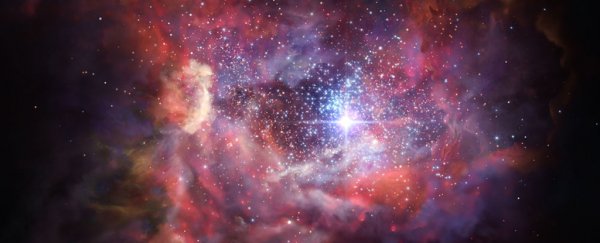Astronomers have spotted the oldest cosmic dust ever discovered, from just 200 million years after the birth of the first stars - dust that could help us learn more about the origins of our Universe.
Cosmic dust is a crucial microscopic building block of stars, planets, and even you and I, making it useful for figuring out how early galaxies formed - and we've just found enough of the ancient stuff to fill our Sun 6 million times over.
Researchers from University College London in the UK say the find gives us new insight into the births and explosive deaths of the very first stars in the Universe.
The youthful galaxy in question is called A2744_YD4, discovered with the Atacama Large Millimeter Array (ALMA) observatory and the Very Large Telescope (VLT) in Chile, plus the benefit of gravitational lensing from a galaxy cluster called Abell 2744.
Gravitational lensing involves using objects between Earth and distant light sources as magnifiers, in this case making A2744_YD4 appear almost twice as big to our telescopes.
While cosmic dust is abundant today, it was originally in short supply in the Universe, so by tracing its origins, we can get an idea of what the very early Universe was like.
We know supernova explosions spew out a lot of dust, so the researchers think the discovery of such a large amount of it suggests several stars had already died out in A2744_YD4, during the first 600 million years of the Universe.
"Not only is A2744_YD4 the most distant galaxy yet observed by ALMA, but the detection of so much dust indicates early supernovae must have already polluted this galaxy," says one of the team, Nicolas Laporte.
Thanks to the power of ALMA and the VLT, astronomers can peer ever further out into the galaxy and accordingly further back in time, with the ultimate goal of finding out when the first hot stars existed, the time known as the cosmic dawn.
A2744_YD4 will be much older now, because its light has taken billions of years to reach us, so the telescopes are kind of like optical time machines that let us peer back in time.
"The Hubble and Spitzer Space Telescopes provided us with important information about the distance of A2744_YD4, but it's only thanks to powerful instruments like X-Shooter and ALMA that we can confirm the nature of this distant dusty galaxy," says one of the researchers, Guido Roberts-Borsani.
The team estimates that the young A2744_YD4 was generating some 20 solar masses per year - an astronomical measure equivalent to the mass of our Sun - while our own Milky Way galaxy produces just one solar mass per year today.
There are still a lot of questions to answer about how cosmic dust survives fiery supernovae, and also just when exactly these first stars appeared, but this discovery is a significant step towards understanding the very earliest moments of the Universe.
"Further measurements of this kind offer the exciting prospect of tracing early star formation and the creation of the heavier chemical elements even further back into the early Universe," says Laporte.
You can see the findings summarised in the video below:
The study has been accepted for publication in an upcoming edition of The Astrophysical Journal Letters. Until then, you can read the preprint version at arXiv.org.
